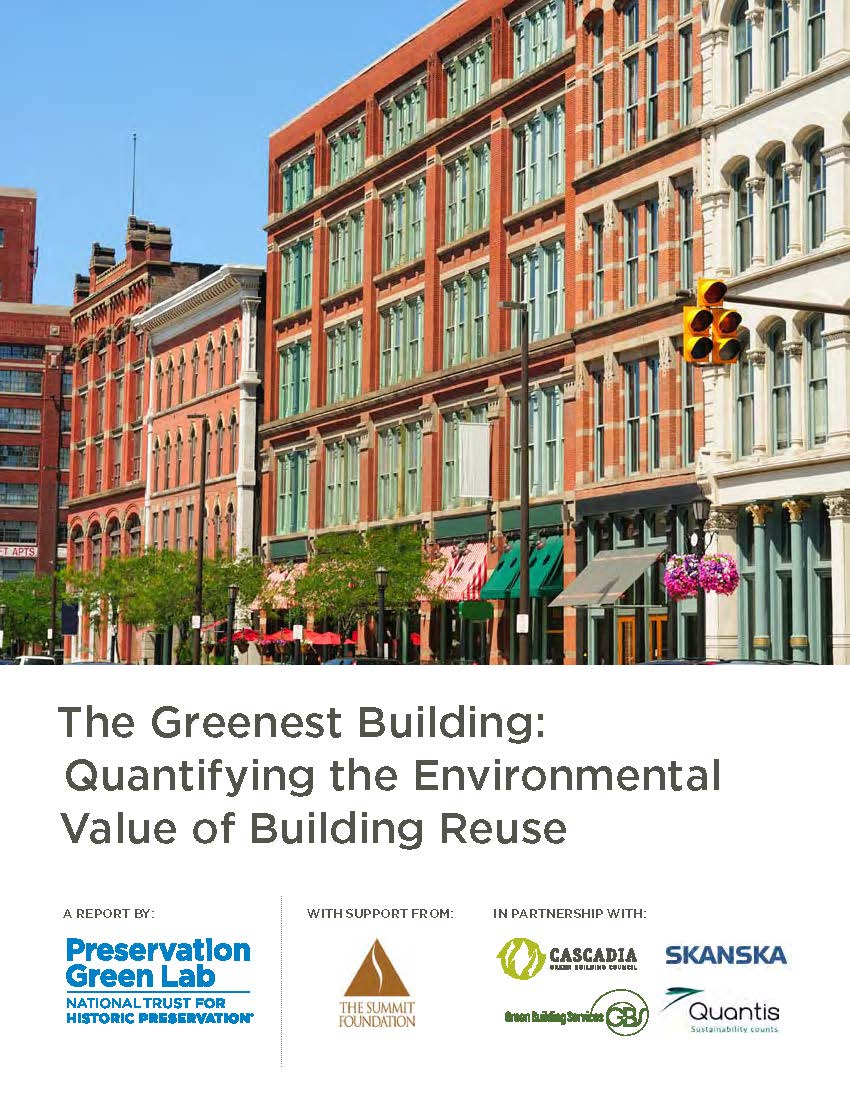Sustainability - Resources for Addressing Climate Change Through Preservation
The definition of sustainability from the U.N. World Commission on Environment and Development's 1987 report, "Our Common Future" is "meeting the needs of the present without compromising the ability of future generations to meet their own needs." The intersection of sustainable design and historic preservation meets this definition.
Building "recycling" is most efficient at conserving energy and resources. Older and historic buildings comprise more than half of the existing buildings in the United States. Retention and adaptive reuse of these buildings preserves materials and embodied energy already expended in procurement and construction. The Preservation Green Lab of the National Trust for Historic Preservation conducted case studies of seven different building types in four different climates to compare the environmental impact of renovation over new construction. In almost every category and building type, the environmental impacts of renovation were less than new construction, confirming the value of building renovation over new construction on the environment. Download the complete report: The Greenest Building Report.
Guidelines For Green and Historic Rehabilitations
There are a number of publications, articles and organizations providing guidance for the appropriate incorporation of current sustainable features and the rediscovery and repair of existing passive features for historic rehabilitation projects.
National Park Service Technical Preservation Services have been promoting energy conservation means and methods since the initial concern about energy efficiency in the 1970s. They maintain a sustainability web page with definitive guidance to incorporate sustainable design with historic resources, and a weatherization web page with information to upgrade homes.
The National Trust for Historic Preservation has equally promoted the inherent energy and material conservation features of rehabbing historic buildings through its publications from the Preservation Press. The National Trust additionally updates their website with the latest developments in sustainable preservation.
Windows and Energy Conservation: Studies + Research
Repair or replacement of original windows is always one of the hottest topics in preservation. There are reasons to replace windows that are too deteriorated to be technically feasible to repair, but energy conservation is not a reason in and of itself to replace an original window.
A report produced by the National Trust for Historic Preservation Green Lab provides cost guidance for homeowners weighing the financial and energy tradeoffs between replacing or repairing older, less efficient windows. This report, "Saving Windows, Saving Money: Evaluating the Energy Performance of Window Retrofit and Replacement", builds on previous research by examining multiple window improvement options, comparing them to replacement windows across multiple climate regions.
Key findings offer homeowners, contractors, architects and others with compelling evidence of the merits of retrofitting windows as opposed to outright replacement:
-
Retrofit measures can achieve performance results comparable to new replacement windows. This study shows that there are readily available retrofit measures that can achieve energy savings close to new, high performance replacement windows when the performance for each upgrade option is taken into account.
-
Almost every retrofit option offers a better Return on Investment (ROI) than replacement windows. Findings from the cost analysis showed that new, high performance windows are by far the most expensive measure, costing at least double that of common retrofit options when considering materials, installation and general construction commonly required for an existing home. In all climate zones analyzed, cellular shades, interior storm panels and various exterior storm window configurations offer a higher average return on investment compared to new, efficient replacement windows.
-
The Bottom Line. Retrofitting windows with high performance enhancements can result in substantial energy savings across a variety of climate zones. Selecting options that retain and retrofit existing windows are the most cost effective way to achieve these energy savings and to lower a home’s carbon footprint. Retrofits extend the life of existing windows, avoid production of new materials, reduce waste and preserve a home’s character.

